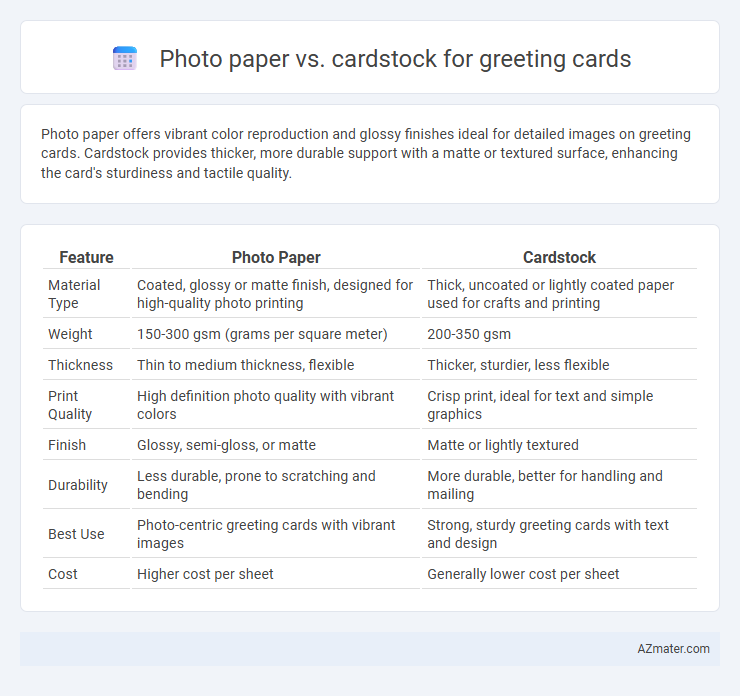Photo paper offers vibrant color reproduction and glossy finishes ideal for detailed images on greeting cards. Cardstock provides thicker, more durable support with a matte or textured surface, enhancing the card's sturdiness and tactile quality.
Table of Comparison
| Feature | Photo Paper | Cardstock |
|---|---|---|
| Material Type | Coated, glossy or matte finish, designed for high-quality photo printing | Thick, uncoated or lightly coated paper used for crafts and printing |
| Weight | 150-300 gsm (grams per square meter) | 200-350 gsm |
| Thickness | Thin to medium thickness, flexible | Thicker, sturdier, less flexible |
| Print Quality | High definition photo quality with vibrant colors | Crisp print, ideal for text and simple graphics |
| Finish | Glossy, semi-gloss, or matte | Matte or lightly textured |
| Durability | Less durable, prone to scratching and bending | More durable, better for handling and mailing |
| Best Use | Photo-centric greeting cards with vibrant images | Strong, sturdy greeting cards with text and design |
| Cost | Higher cost per sheet | Generally lower cost per sheet |
Introduction to Greeting Card Materials
Photo paper offers a smooth, glossy finish that enhances vibrant colors and sharp image details, making it ideal for photographic greeting cards. Cardstock provides a thicker, more durable texture with a matte or textured surface, ensuring rigidity and a premium feel for personalized messages. Selecting between photo paper and cardstock depends on the desired visual impact and sturdiness for the greeting card.
What is Photo Paper?
Photo paper is a specially coated paper designed to enhance the quality of printed images with vibrant colors and sharp details, making it ideal for photographic prints and high-resolution images. Its smooth, glossy, or matte finish enhances color saturation and contrast, providing a professional appearance for greeting cards. Unlike cardstock, photo paper is thinner and less rigid, which may affect durability but offers superior image clarity and vividness for personalized greeting cards.
What is Cardstock?
Cardstock is a heavyweight paper known for its thickness and durability, making it ideal for greeting cards that require sturdiness and a professional finish. Unlike photo paper, which is glossy and designed for high-quality image printing, cardstock provides a matte or textured surface that enhances writing and supports various printing techniques. Its fiber composition and weight, typically ranging from 80 to 110 pounds, make cardstock resistant to bending and perfect for creating long-lasting greeting cards.
Print Quality: Photo Paper vs Cardstock
Photo paper offers superior print quality for greeting cards due to its glossy or satin finish, intensifying colors and enhancing image sharpness with high-resolution prints. Cardstock, while thicker and more durable, absorbs ink differently, often resulting in a matte or slightly textured finish that can mellow colors but provides a sturdy feel. Choosing photo paper ensures vibrant, detailed visuals, whereas cardstock emphasizes durability with a classic, tactile quality.
Durability and Wear Resistance
Photo paper offers vibrant color reproduction but lacks the durability needed for long-term greeting cards, often showing signs of wear such as creasing or bending. Cardstock, made from thicker and sturdier material, provides superior wear resistance, maintaining its shape and integrity through handling and mailing. Choosing cardstock enhances the lifespan and professional appearance of greeting cards due to its high durability and resistance to physical damage.
Texture and Finish Comparison
Photo paper offers a glossy or satin finish that enhances color vibrancy and detail, making images appear sharp and vivid for greeting cards. Cardstock features a thicker, more textured surface, such as matte or linen finishes, providing a sturdy feel and a tactile quality that conveys durability and craftsmanship. The choice between photo paper and cardstock depends on whether you prioritize sleek image reproduction or a substantial, textured tactile experience.
Color Vibrancy and Image Reproduction
Photo paper offers superior color vibrancy and sharper image reproduction due to its smooth, coated surface designed to absorb ink precisely, making images appear more vivid and lifelike. Cardstock, while thicker and more durable, tends to have a matte or lightly textured finish that can slightly dull colors and soften image details. For greeting cards emphasizing rich, bright visuals and fine photographic quality, photo paper is the optimal choice, whereas cardstock is preferred for a sturdy feel with slightly muted tones.
Suitability for Different Greeting Card Styles
Photo paper offers a glossy finish ideal for vibrant, photo-centric greeting cards, enhancing image clarity and color depth, which suits photographic or digitally designed styles. Cardstock provides a sturdy, matte or textured surface, perfect for handmade, pop-up, or layered greeting cards that require durability and support for embellishments. Choosing between photo paper and cardstock depends on the desired aesthetic and structural needs of the greeting card style, with photo paper favoring visual impact and cardstock supporting tactile creativity.
Cost and Availability
Photo paper offers vibrant color quality for greeting cards but tends to be more expensive and less widely available in larger sizes compared to cardstock. Cardstock is cost-effective, readily accessible in various weights and textures, making it a popular choice for bulk greeting card projects. Businesses and hobbyists favor cardstock for its durability and affordability without sacrificing the professional feel of the final card.
Which Should You Choose for Your Greeting Cards?
Photo paper offers vibrant color reproduction and a glossy finish, ideal for detailed images and high-quality photo greeting cards. Cardstock provides a thicker, more durable feel with a matte or textured surface, making it perfect for personalized messages and handcrafted cards. Choosing between photo paper and cardstock depends on whether you prioritize image quality or card sturdiness for your greeting cards.

Infographic: Photo paper vs Cardstock for Greeting card
 azmater.com
azmater.com